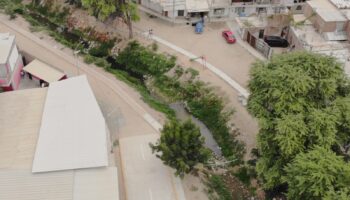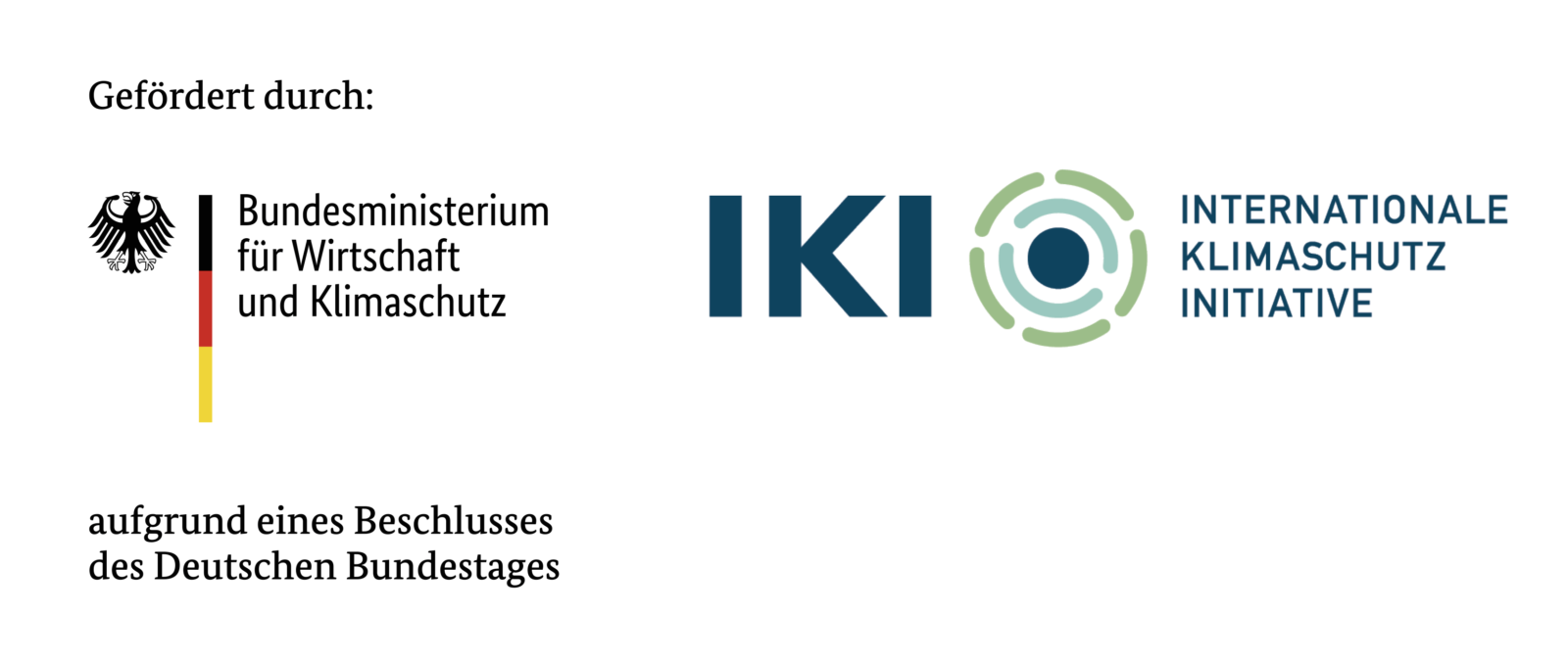MGI Experteninterviews - Podcast
Folge 1: Frauen in Städten und die Klimakrise

- Skript und Bearbeitung: Sarah Walz
- Interview: Sarah Walz & Trinidad Fernández
- Musik von ©Roland Kah, https://ronaldkah.de/
Transkript
Sarah: Welcome to the expert interviews by the Morgenstadt Global Smart Cities Initiative. Women hold only 10% of the highest-ranking positions as architects and urban planners worldwide. The female share of the population as well as gender minorities are rarely considered in the urban planning and design process. Historically speaking, most cities have been planned and designed by men for men. My name is Sarah Walz and with my colleague Trinidad Fernandez, we are talking today with Juliet Kariuki. Juliet is a gender consultant and an expert for gender related issues in the context of development.
Juliet, to start with, could you explain why it is important to consider the aspect of gender and sustainable urban development and the design process of cities?
Juliet: [0:56] I think it’s important because cities are used by both men and women. This is something that we often take for granted. In most cities or in most countries, the percentage of women is actually higher than the percentage of men. But men and women use or access infrastructure in different ways and for different reasons.
“It is important to understand the needs that both men and women have for infrastructure and ur-ban development.”
So, it’s important to understand the needs that both men and women have for infrastructure and urban development. If you take, for example, the issue of a public space, – a public bathroom, let’s say, – men and women have totally different needs: you design a bathroom for men to have a urinal and a wash basin. You design a bathroom for women to have maybe a baby changing table, a toilet, and somewhere else to wash their hands. And that’s a very simple example of the fact that men and women have different needs. They utilize the same spaces, but in different ways and for different reasons.
Sarah: [2:05] Talking about different needs and using the space differently, what would you say is necessary to change on a structural level so to make cities more gender inclusive?
Juliet: [2:20] I think that sanitation is one of the big issues. We’ve kind of covered that. But also road infrastructure that is inclusive of a space that’s not just for cyclists but also a space for women who might have prams, for example. I think that is also one of the discussions. And then in terms of urban transportation, making sure that there are designated spaces for women who might be carrying their children with them. In the same way we would also consider the elderly. I think this happens very often in Europe, but maybe not so much in the countries where the project is taking place.
Thinking about the countries where the projects are being implemented, another issue is the proximity of services to where people live. Often men will have more access to urban services than women do because women are often involved in the domestic chores. And if there is a bus stop that is located quite far away from the home, it might be easier for men to access public transport than it would be for women. So, what sorts of alternatives exist? Are there, for example, intermediary transport services that can get women from their homes to the bus stop that is located far away and then into the city? So, it’s not just the city, it’s beyond. It’s how to access the city as well which should be taken into consideration. Those are some ideas that might be worth taking notes on.
Sarah: [4:10] You have given some examples on how we can address certain inconveniences for women in cities. Are there any other insufficiencies or even dangers for girls and women in urban areas that can be addressed through structural changes?
Juliet: [4:32] I think another important one, structurally, is lighting. Having green spaces but having green spaces that are also well lit. More and more, we’re finding that women are engaging in jobs that maybe are halftime jobs. Maybe they have to leave early in the morning. Maybe they have to come back late at night, and they have to go through some of these open areas. And a lot of research does show that when you invest in even street lighting, park lighting, for example, this can reduce the incidences of crime. In the case of Kenya, for example, that having more lighting has reduced crime against women significantly. So that’s another structural suggestion.
Sarah: [5:22] Generally, what would your advice be to a city administrator or a city planner if they wanted to make a city more gender inclusive, more equal and safer?
Juliet: [5:37] The first thing is: include women in the planning from the beginning. Don’t design a city without consulting with its inhabitants. You know, this seems like a very straightforward thing, but as we know, the voices of the voiceless are often overlooked. And ask directly because it could be, for example, that women in Peru are happy to have a bicycle lane because they can use their bicycles. But for women in India, the culture might dictate that women should not use bicycles but should instead use tuk-tuks.
“Include women in the planning from the beginning. Don’t design a city without consulting with its inhabitants. But, as we know, the voices of the voiceless are often overlooked.”
So, it is important to get a context specific understanding from the outset and then to be able to have more participatory approaches as the planning goes forward with both men and women representatives. Because that way it’s much more demand driven. So, you can really use a project cycle approach, even for something like this, where you bring in the users from the outset. And there’s all sorts of different activities that can be implemented as the project planning process goes along.
And invest the time to understand what are the risks that both men and women face in urban areas. Do research to find out what sorts of interventions can reduce those risks, such as street lighting, like we talked about. Or in some countries, I think they have taxi lanes, which is great, but then they also have female driven taxi drivers, things like this. But you have to have a road that can accommodate for taxis or public transport, rapid transport systems. Those would be some ideas from the top of my head.
Trinidad: [7:27] What you were mentioning was very related to what should planners consider and this idea of having gender inclusion and women-based planning from the very beginning. But I would like to know, in your opinion, why is this not happening? What is missing? How can we materialize this idea in our cities? In your opinion, what is hindering this process?
Juliet: [7:59] I think one of the things that’s hindering this process is that a lot of disciplines operate in isolation. Trinidad, you studied architecture and urban planning. Did you learn anything about sociology?
Trinidad: [8:18] Well, I was interested, but not really, that’s true.
Juliet: [8:22] You would have to have gone out your way to attend maybe other modules. Our education system is sometimes a bit isolated and that translates into how we operate in the professional world. And I believe this is one of the real challenges facing more inclusive planning. This also includes people with disabilities, who are also part of our society but sometimes we tend to overlook them, especially in developing countries or middle-income countries.
“Our education system is sometimes a bit isolated and that translates into how we operate in the professional world. And I believe this is one of the real challenges facing more inclusive planning.”
On the other hand, I think that the narrative of the Sustainable Development Goals really forces us to think about that meeting those Sustainable Development Goals cannot be achieved if we don’t address gender. If you look at every single Sustainable Development Goal, none of them can be achieved if we don’t address half of the world’s population. So, we are now being forced to think outside of the box and to interact with people in different disciplines in a way that is more meaningful. I see that the obstacles are there, but the transition towards a more inclusive approach is definitely under way. – Like this discussion we’re having now.
Sarah: [9:55] To shift a little bit the focus of our conversation: in the context of sustainable urban development, climate change and its consequences must be taken into account as well. So, how are girls and women affected differently by the consequences of climate change than, for example, boys and men?
Juliet: [10:15] The main finding has really been that there is this gender gap that women have less access to resources than men. In the context of climate change this makes women more vulnerable to droughts, more vulnerable to floods. Then there is how women are dressed. I’ve come across research that shows that cultural norms around how women dress makes them more vulnerable when there’s a flood. Cultural norms about whether women should climb trees makes them more vulnerable when there is a flood. Things like this that are very deep seated.
The challenge is here that women are much more exposed and much more vulnerable to climatic changes. And as a result, this makes coping and mitigating climatic change much more of a challenge for women than it is for men.
But more than anything it’s that women have less access to finances and less access to the resources that they need to combat climate change at the household level. And this is really something that cuts across most societies. The challenge is here that women are much more exposed and much more vulnerable to climatic changes. And as a result, this makes coping and mitigating climatic change much more of a challenge for women than it is for men. What I do know is that when it comes to the aspects of drought or risks in general, women tend to have less access to finances in order to manage these risks. So, in terms of insurance, in terms of access to loans or credit, men can usually access these services much better than women in the aftermath of a climatic event.
Sarah: [12:13] Talking about the development of cities, how do these inequalities you mentioned manifest themselves in an urban context?
Juliet: [12:24] Often, the gender research looks at these climate change and vulnerabilities from a gender perspective in rural areas. So this is quite interesting. I would imagine that the water issue would affect women a little bit more than men. In an urban area, you want to make sure that there is access to water. – Not just for women, we’re not saying there should be women centered drinking spots or whatever. But the role of women in managing water resources is quite high in rural and in urban areas. So it could be that infrastructure could take into consideration introducing more water points for both men and women, with the understanding that women actually are responsible for taking water back to their homesteads.
“It is really important to integrate not just women and men’s voices, but to integrate voices from different classes of society, because gender is very intersectional.”
Maybe another interesting aspect could be how to build urban areas with this in mind: the fact that rural urban migration is very gendered. For cities that are growing fast, uncontrollably, you have a growing peri-urban population, but you also have a growing population of slums. And I think that, when designing these cities, it is really important to integrate not just women and men’s voices, but to integrate voices from different classes of society, because gender is very intersectional. For example, the needs of a black poor woman would be very different from the needs of a black educated woman. The needs of an elderly Indian woman would be very different from the needs of a young Indian woman. So, you need to have these different categories because they all are self-reinforcing, and there’s not really a uniform sort of statement where you can say climate change affects women differently. It’s actually much deeper than that.
When designing the cities, I think it’s important to also have different categories of women as well as different categories of men. And the issue is really as for it to be gender-inclusive, you also have to include men, because there are dangers of just working with women. Especially in rigid cultural contexts it’s really important to include men and not focus just on women, because this can lead to a lot of backlashes. So, the togetherness aspect requires a few additional skills, and that’s part of the gender aspect rather than a more feminist approach, which would be just focus on women.
Trinidad: [15:50] Mentioning skills, how do you see the importance of education as enable to reach this gender-based planning?
Juliet: [15:58] In terms of education for planners I certainly think there’s room for more interdisciplinary education. The ongoing learning on the job is one thing, but then I think there’s also this component of continued education. It could be training courses from time to time on different topics. And I think there’s a need for cities to keep their planners up to date with new innovative approaches, new ways of thinking. Not to overload, but I think it should be built into the system. Maybe they take a course on climate change, maybe they take a course on peri-urban livestock, whereby that knowledge can be built into their work.
Sarah: [16:51] Before we come to an end, we have covered various aspects of why and how to include gender in the planning and development of cities. But is there an action or a policy that you would consider as most effective to tackle the challenges we have talked about?
Juliet: [17:13] Yeah, I would really say the most effective policy, – and this reiterates what I said before -, include men and women in the planning process from the beginning. Cities are huge investments. Once you’ve constructed or planned the city and it’s an infrastructure already in place, it’s quite difficult to go back and remodel the city. But that’s pretty much what is happening in many cities, a lot of remodeling. So, if that’s the case, of course, then include men and women from different classes and different age sets from the beginning.
It could even mean having different discussions with schoolchildren, having discussions with female headed households, having discussions with housewives. This would be the ideal. And I know that the main constraint is always of financial implications. But work with the users, and the users are men and women of different ages and ethnic backgrounds and cultures.
Sarah: [18:23] Thank you, Juliet. Thank you so much for this conversation and your insights into the topic.
Trinidad: [18:28] Me too. It’s always a pleasure to talk to you.




